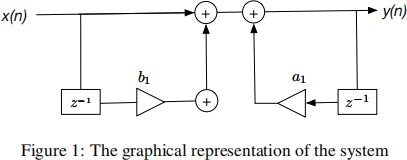关键词 > CE335
CE335 DIGITAL SIGNAL PROCESSING Undergraduate Examinations 2022
发布时间:2024-06-17
Hello, dear friend, you can consult us at any time if you have any questions, add WeChat: daixieit
CE335-6-AU
Undergraduate Examinations 2022
DIGITAL SIGNAL PROCESSING
Question 1
(a) Consider the following signal x(t) at fs = 10, 000 samples/second.
x(t) = 3 cos(2π500t - π/5) + 6 cos(2π700t + π/5) + 4 cos(2π600t + 2π/7)
(i) How many samples would we have after 16 ms? [2%]
(ii) What is the sine and cosine representation of x[0] and x[1]? Compute the value for x[0]
(Hint: observe that it needs to be in sine and cosine). [6%]
(iii) What is the lowest frequency, highest frequency, and Nyquist rate of x(t)? [4%]
(b) Consider the following system, T (x[n]) = ex[n], and step by step determine whether it [6%]
satisfies the following properties: causality, linearity, time invariance.
(c) Consider a system with the following impulse response: [8%]

What is the input x(n) for 0 ≤ n ≤ 8 that will generate the following output sequence, y(n)? (Hint: y(n) = x(n)h(n))

(d) In the Welch method for power spectral density (PSD) estimation, the segments’ overlapping length is M-D, where M is the length of each segment and D is the non-overlap length. If the signal length is N = 250, the number of segments is K = 6,and M = 150, what is the percentage of overlapping between the segments? What are the advantages and disadvantages of the Welch method? [6%]
Question 2
Consider the following four-point sequence x[n] and h[n] as follows:

(a) What is the four-point DFT X[k] in terms of W? [5%]
(b) What is the four-point DFT H[k] in terms of W? [5%]
(c) Calculate y[n] = x[n]![]() h[n] by doing the circular convolution directly and sketch the graphical representation of the output. [5%]
h[n] by doing the circular convolution directly and sketch the graphical representation of the output. [5%]
(d) Calculate y[n] of part(c) by multiplying the DFT outputs of x[n] and h[n] in terms of W and [7%] performing an inverse DFT.
(e) Find the transfer function of the system given in Figure 1 and calculate the magnitude and [10%]

phase response of it. The values for the variables are as follows: b1 = 0.5, a1 = 0.5.
Question 3
The transfer function H(z) of an IIR filter is given by:

(a) Derive the relationship between the input x(n) and the output y(n) of the filter. [4%]
(b) Find the zeroes and the poles of the filter and sketch the poles and zeroes. [Hint: az2 + bz + c = (z − z1)(z − z2),  [8%]
[8%]
(c) Rewrite the transfer function so that it is a cascade of an all-pass filter with transfer function [10%]
Hap (z) and another filter with transfer function H1 (z)., i.e. H(z) = Hap (z)H1 (z). Show your calculations step by step and sketch the zeros-poles diagram of the all-pass filter.
(d) Draw the cannonical implementaiton of the original filter. How many delay units are required? [6%]
(e) What is the group delay for 0 < w < π for each of the following sequences:
(i) [4%]

(ii) [4%]


